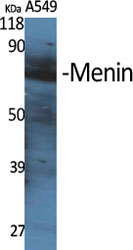产品名称
Menin Rabbit Polyclonal Antibody
存储缓冲液
Liquid in PBS containing 50% glycerol, 0.5% BSA and 0.02% New type preservative N.
Human Gene Link
http://www.ncbi.nlm.nih.gov/sites/entrez?db=gene&term=4221
Human Swissprot No.
O00255
Human Swissprot Link
http://www.uniprot.org/uniprotkb/O00255/entry
Mouse Gene Link
http://www.ncbi.nlm.nih.gov/sites/entrez?db=gene&term=17283
Mouse Swissprot No.
O88559
Mouse Swissprot Link
http://www.uniprot.org/uniprot/O88559
Rat Gene Link
http://www.ncbi.nlm.nih.gov/sites/entrez?db=gene&term=29417
Rat Swissprot Link
http://www.uniprot.org/uniprot/Q9WVR8
免疫原
The antiserum was produced against synthesized peptide derived from human MEN1. AA range:181-230
特异性
Menin Polyclonal Antibody detects endogenous levels of Menin protein.
稀释度
WB 1:500 - 1:2000. IHC 1:100 - 1:300. ELISA: 1:20000.. IF 1:50-200
宿主
Polyclonal, Rabbit,IgG
背景介绍
This gene encodes menin, a putative tumor suppressor associated with a syndrome known as multiple endocrine neoplasia type 1. In vitro studies have shown menin is localized to the nucleus, possesses two functional nuclear localization signals, and inhibits transcriptional activation by JunD, however, the function of this protein is not known. Two messages have been detected on northern blots but the larger message has not been characterized. Alternative splicing results in multiple transcript variants. [provided by RefSeq, Oct 2008],
细胞定位
Nucleus . Concentrated in nuclear body-like structures. Relocates to the nuclear matrix upon gamma irradiation.
功能
disease:Defects in MEN1 are the cause of familial isolated hyperparathyroidism (FIHP) [MIM:145000]; also known as hyperparathyroidism type 1 (HRPT1). FIHP is an autosomal dominant disorder characterized by hypercalcemia, elevated parathyroid hormone (PTH) levels, and uniglandular or multiglandular parathyroid tumors.,disease:Defects in MEN1 are the cause of familial multiple endocrine neoplasia type I (MEN1) [MIM:131100]; an autosomal dominant disorder characterized by tumors of the parathyroid glands, gastro-intestinal endocrine tissue, the anterior pituitary and other tissues. Cutaneous lesions and nervous-tissue tumors can exist. Prognosis in MEN1 patients is related to hormonal hypersecretion by tumors, such as hypergastrinemia causing severe peptic ulcer disease (Zollinger-Ellison syndrome, ZES), primary hyperparathyroidism, and acute forms of hyperinsulinemia.,function:May be involved in DNA repair.,PTM:Phosphorylated upon DNA damage, probably by ATM or ATR.,subcellular location:Concentrated in nuclear body-like structures. Relocates to the nuclear matrix upon gamma irradiation.,subunit:Interacts with FANCD2 and DBF4. Component of MLL-containing complexes (named MLL, ASCOM, MLL2/MLL3 or MLL3/MLL4 complex): at least composed ASH2L, RBBP5, DPY30, WDR5, one or several histone methyltransferases (MLL, MLL2, MLL3 and/or MLL4), and the facultative components MEN1, HCFC1, HCFC2, NCOA6, KDM6A, PAXIP1/PTIP and C16orf53/PA1.,tissue specificity:Ubiquitous.,
纯化
The antibody was affinity-purified from rabbit antiserum by affinity-chromatography using epitope-specific immunogen.

.jpg)
